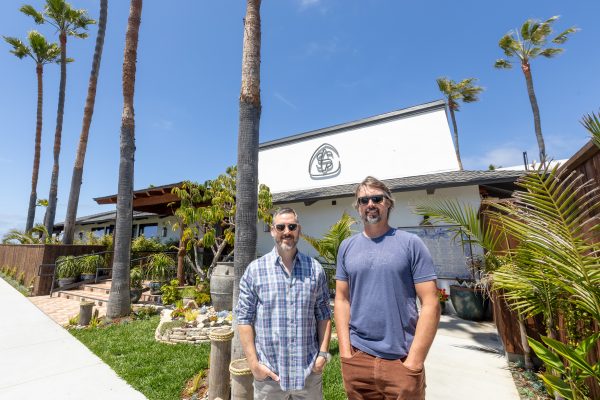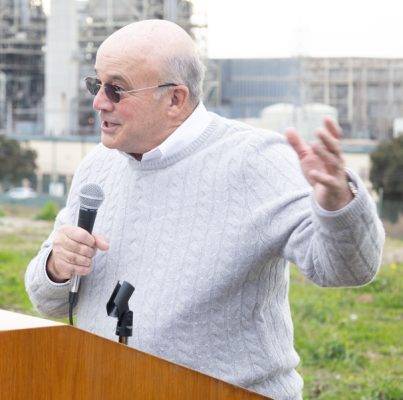
Authoritative estimates of Hermosa Beach oil royalties, assuming voters lift the oil drilling ban on March 3, were made public last week with the release of Kosmont Company’s “City of Hermosa Beach Oil Drilling and Recovery Analysis.” Kosmont also addressed how the city can spend those royalties, but with notably less authority.
A flashpoint in the report is Kosmont’s statement that, “To the extent that a city is unable to find appropriate uses for Tidelands oil and gas revenues, a significant portion of such funds may be diverted to the state.” Kosmont estimates that 78 percent of Hermosa’s potential oil revenue will come from its tidelands
The report was paid for by the city and is prefaced with a note that reads, “The authors neither support nor oppose the proposed project. In the authors’ opinion, this report presents a neutral and unbiased perspective.”
E&B Natural Resources proposes to drill 30 wells from the city’s maintenance yard at Sixth and Valley Drive into the city’s tidelands.
Kosmont’s estimates of the city’s royalties in last week’s report are essentially the same as the estimates in Kosmont’s preliminary report, released last March.
Like the March report, the final cost benefit analysis estimates Hermosa Beach will receive between $118 million and $270 million over the project’s 35-year lifespan, should voters lift the drilling ban.
If voters uphold the drilling ban the city will owe E&B $17.5 million, under the terms of an agreement approved by the city council in 2012. The city has set aside $6 million to pay the debt, leaving $11.5 million that would need to be financed. Kosmont Companies estimates the financing costs at $850,000 to $1.1 million a year for the next 20 to 30 years. Hermosa’s annual budget is approximately $40 million.

Plus or minus a few hundred million
In addition to Kosmont’s revenue projections, the report includes E&B’s substantially higher projections.
E&B estimates its project will produce $519 million for the city, an amount that is almost double Kosmont “high” estimate of $270 million, and more than double Kosmont’s “expected” estimate of $201 million.
E&B spokesperson Eric Rose said Monday, “We stand by the Berkeley Research Group’s report, which shows that the total financial benefit to the City is estimated at $519 million over the course of the project, with about 80 percent coming in the first 15 years.
Following publication of Kosmont’s preliminary report in March, E&B vice president of Health, Safety and the Environment and Government Affairs Mike Finch said the differences between Kosmont’s and E&B’s figures were attributable to three factors.
Kosmont did not include revenue from zones in the tidelands reservoir known as the Shist and Lower Del Amo layers because it lacked reports on those zones. The Kosmont report acknowledges that oil in those zones “could contain 34 percent of the reservoir volume.”
Secondly, Finch said, Kosmont put the oil recovery rate at eight percent. E&B estimates it will be 15 to 20 percent. Recover rate refers to the percent of oil in a reservoir that can be extracted.
A third explanation for the projection differences, Finch said, is that Kosmont calculated revenue at $95 a barrel. E&B used $105 a barrel.
Like the preliminary report of last March, the final Kosmont analysis anticipates Hermosa’s schools receiving $1.1 million to $2.2 million over the life of the project. But the Kosmont report does not include E&B’s offer last month to increase its contribution to the schools from 20 cents a barrel to one percent of all oil revenue. E&B estimates this will raise $36.75 million over the project’s 35-year lifetime, with roughly $7 million going directly to the school district and $30 million to the Hermosa Beach Education Foundation.
Stop Hermosa Beach Oil spokesperson Stacey Armato said of the Kosmont report, “The report proves the oil company has been using grossly exaggerated oil production estimates… Those inflated projections are a clear attempt to mislead Hermosa Beach voters. The report reaffirms how extremely restricted the city would be in its ability to spend oil revenue. Only 26 percent of the city’s oil revenue share could be spent on city services or infrastructure… The report also verifies that no one knows exactly how much oil revenue the city will receive, and that amount will not be realized for some thirty-five years.”

It’s complicated
Much of Kosmont’s 118 page report (and 255 pages of appendices) is devoted to the complicated issue of how the city may spend the anticipated oil revenue.
The complications begin with the fact that the royalties are divided between upland and tideland funds.
Upland royalties come from oil and gas recovered from beneath Hermosa Beach. This will account for an estimated $25 million to $77 million of the city’s revenue (roughly 21 percent to 29 percent of overall city royalties).
E&B estimates the city’s uplands revenue to be $139 million. Uplands funds would be deposited in the city’s general fund, which cities are generally free to spend as they wish. But Hermosa’s oil royalties come with a uniquely Hermosa restriction.
In 1984, voters overturned the 1932 drilling ban in hopes of using oil royalties to purchase the abandoned Santa Fe Railroad right-of-way for open space. The block-wide strip of land stretches from the north end to the south end of town. Not trusting the council to use the anticipated oil funds for their intended purpose, language was added to the ballot measure that read: [Oil revenue will be used for] acquisition, maintenance and improvement of available excess school or other properties for open space and parkland purposes.”
(The city subsequently acquired the Santa Fe right-of-way with county funds, leading voters to reinstate the ban on oil drilling in 1995).
Unless the city wants to use uplands oil money exclusively for open space, the Kosmont report states, this restriction needs to be lifted by voters. The council has indicated voters will be asked to lift the spending restriction at the same time they are asked to lift the drilling ban.
Redondo did it
Tidelands royalties come with still more complicated restrictions. Oil recovered from between the city’s mean high tide line and a mile out to sea are subject to the 1919 State Tidelands Grant. Kosmont estimates that $148 million or 78.3 percent of the city’s oil revenue will come from its tidelands. E&B puts the city’s share of tidelands revenue at $311 million.
The California State Lands Commission Public Trust Doctrine reads, ‘Uses of trust funds…are generally limited to those that are water dependent or related and include commerce, fisheries, and navigation, environmental preservation and recreation…”
It further states, “They must be used to serve statewide, as opposed to purely local public purposes.”
The California State Lands Commission (CSLC) has agreed to allow the city to place 37 percent of its tidelands royalties in its general fund to pay for expenses related to drilling from the city maintenance yard at Sixth Street and Valley Drive, five blocks from the beach. But the Kosmont report offers no suggestions on how to spend the remaining 62.5 percent of tidelands oil revenue.
Its draft report released last March stated, “To the extent that a city is unable to find appropriate uses for Tidelands oil and gas revenues, a significant portion of such funds may be diverted to the state.”
That language remains in the final draft, released last week, despite E&B’s strongly worded objection to the language in the March report.
In an April 11, 2014 letter to Hermosa Beach Community Development Director Ken Robertson, E&B attorneys Hollister and Brace wrote” “This statement is misleading and requires clarification to avoid confusion. Diversion to the State is not something that happens automatically, but instead requires specific Legislative amendment to the City’s grant.”
The letter goes on to state, “Visitor-serving facilities, such as restaurants, hotels, shops, and parking areas, have also been upheld by the courts as appropriate public trust commercial uses.
“The underlying rationale is that hotels, restaurants, shops, restrooms and parking areas accommodate or enhance the public’s ability to enjoy tidelands, submerged lands and navigable waterways…
“This has been demonstrated by numerous CSLC decisions, including those involving the neighboring City of Redondo Beach, where Public Trust revenues were used to purchase and improve upland parcels having direct Public Trust benefits…”
“As an example, in the early 1980s, the CSLC approved numerous proposals by the neighboring City of Redondo Beach, through its redevelopment agency, to rehabilitate with Public Trust revenues a blighted area adjacent to King Harbor, known as the Triangle Neighborhood Shopping Center. The plan involved development of a portion of the triangle area with a
353-suite hotel facility together with typical hotel amenities and a community meeting
hall…”
“The CSLC’s approval was conditioned on the requirement that any lands acquired or improvements paid for with Public Trust revenues became assets of the Trust subject to all the provisions of the Trust grant made to the City of Redondo Beach…”
However, Hermosa City attorney Michael Jenkins, in a May 20 memo to the city council, expressed a far more conservative view tidelands revenue spending. Jenkins noted that the city’s tidelands grant “expressly” allows spending on “a harbor, construction of bulkheads and…operations of wharves, docks, piers, slips, quays and other utilities.”
“Implied” uses for the funds include “stormwater and sewer improvement projects that divert polluted waters from flowing into the harbor…”
Recreational activities are expressly prohibited, Jenkins wrote.
After receiving Jenkins’ memo, the city council sought a second opinion from Michael Mills, the city’s outside oil attorney. The council listed 15 civic projects it hoped to spend tidelands funds on. They included improvements to the police, fire, community center and city hall buildings, new playground equipment, salaries for additional police and parking enforcement officers and repairs to sewers and storm drains.
Mills, in his September 11 response, said tidelands money could not be spent on any of the building projects.
He also said no to police and parking enforcement officers “unless such officer/officers were dedicated to patrols/beats within the area of the beach/shoreline/harbor/pier…”
He said yes to sewers “running in the vicinity of the shoreline/harbor” and yes to sewers that “discharge into the tidelands/ocean.”
The Kosmont report suggests that definitive answers on Hermosa’s spending of tidelands royalties will have to be decided case by case by the state or the courts.
“Absent a court legal judgment, the CSLC generally provides a final determination of what is, or is not a permitted use of Tidelands funds,” the report states.
Reading tea leaves
The difficulty in anticipating CLSC opinions is apparent from a significant revision to the Kosmont report made just days before the report’s release.”
The section titled “Oil and Gas Revenues” begins in italics:
Note: Calculations in this section have been substantially changed from those in the Draft CBA.
The figures herein are based on the opinion of CSLC staff in a letter dated September 16, 2014
expressing the staff’s concern about deducting Macpherson’s 3.33% non-participating royalty
from oil and gas revenues produced from the Tidelands.
The preliminary Kosmont report anticipated CLSC approval for use of the restricted tidelands royalties to pay off Macpherson Oil, E&B’s predecessor. The 2012 agreement requires the city pay Macpherson 3.33 percent of all uplands and tidelands oil and gas revenue. Estimates for Macpherson’s royalties range from $50 to $100 million if the oil ban is lifted.
Last month, the council asked the lands commission for assurance that Macpherson could be paid with tidelands money.
State Lands Commission Chief of External Affairs Sheri Pemberton responded, in her September 16 letter, “…staff does not believe that deducting any portion of the 3.3 percent non-participating [Macpherson] royalty payment from the portion of the 18.66 percent [tidelands] royalty…is consistent with the Commission’s prior authorization or the City’s obligations as a trustee for the state.”
Pemberton pointedly added, “Staff does not object to the City paying the entire 3.33%…from the Uplands royalties or the City’s General Fund.”
The implication is the city will have $50 million to $100 million less oil revenue in its general fund to spend as it wishes.
The city council was scheduled to approve the Kosmont report at its Tuesday, September 30 meeting. Language for the March 3 oil ban ballot measure will be discussed at the October 14 city council meeting.











